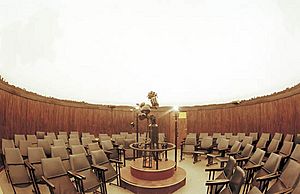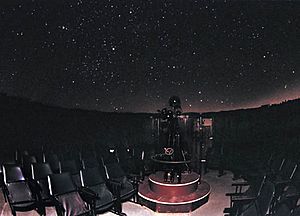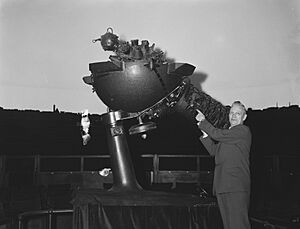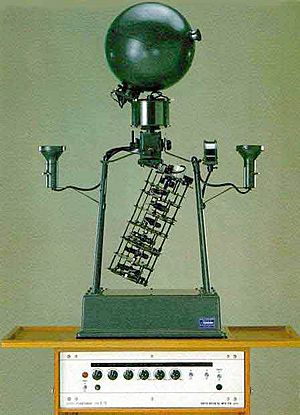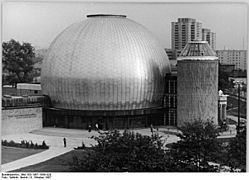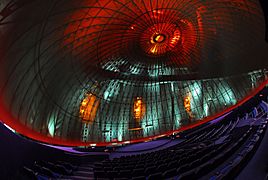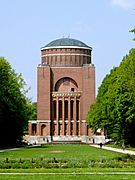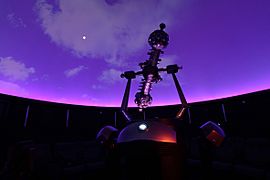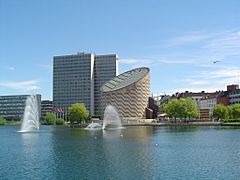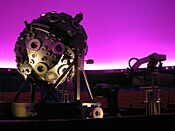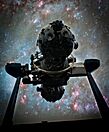Planetarium facts for kids
A planetarium is like a special theatre where you can learn about astronomy and the night sky. It's also used to teach people how to navigate using the stars.
The most important part of a planetarium is its big dome-shaped screen. On this screen, special projectors show images of stars, planets, and other objects in space. These images can move realistically, just like they do in the real sky. Different types of projectors are used, such as "star balls," slide projectors, video systems, and lasers. Planetariums can show you what the sky looked like in the past, what it looks like now, or even how it would appear from different places on Earth.
Planetariums come in many sizes. Some are very large, like the 37-meter dome in St. Petersburg, Russia. Others are small, like three-meter inflatable domes that can be set up anywhere. The Jennifer Chalsty Planetarium in New Jersey is the largest in the Western Hemisphere, with a 27-meter dome. The Birla Planetarium in India can seat the most people, with 630 seats.
Sometimes, the word "planetarium" can also mean other tools that show the Solar System, like computer programs or orreries (mechanical models of the Solar System). A "planetarian" is a person who works at a planetarium.
Contents
History of Planetariums
People have been trying to show how the sky moves for a very long time!
Early Ideas
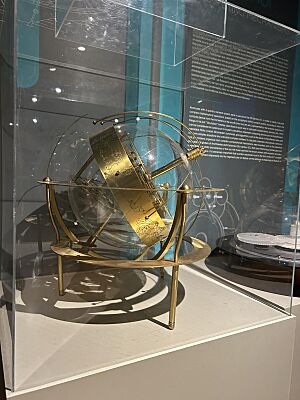
Long ago, a smart Greek thinker named Archimedes might have made an early device to show how the Sun, Moon, and planets move. Later, the discovery of the Antikythera mechanism showed that such complex devices existed in ancient times. These early tools are often called orreries. Many modern planetariums still use projectors to show the Solar System, including the Sun and planets up to Saturn, moving in their paths.
In 1229, after a big journey, Holy Roman Emperor Frederick II of Hohenstaufen brought back a tent with holes that looked like stars. A spinning table inside made the tent rotate.
In the 1700s, people like Adam Walker tried to make bigger versions of these sky-showing devices for public shows. His "Eidouranion" was huge, about 20 feet tall, and made planets seem to float and move on their own. These shows were more about amazing the crowd than being perfectly accurate.
The oldest planetarium that still works today was built by Eise Eisinga in his living room in Franeker, Netherlands. He finished it in 1781, after seven years of work!
Modern Planetariums Begin
In the early 1900s, a German museum director named Oskar von Miller wanted a better way to show the sky. He worked with the Zeiss company to create the first modern planetarium projector. This amazing machine could show all the stars and planets moving from a central spot in a room, projecting onto a white dome.
The very first Zeiss planetarium showed images of the night sky onto a 16-meter dome in August 1923. The first public show was in Munich on October 21, 1923. These Zeiss planetariums quickly became very popular around the world, opening in cities like Rome, Chicago, and Osaka.
After World War II
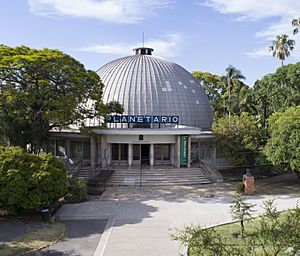
After World War II, the Zeiss company split, but both parts continued to make planetariums. Other companies also started building their own unique projectors.
The "Space Race" in the 1950s and 60s made planetariums even more popular. Many new planetariums were built in high schools across the U.S. to encourage interest in space.
Armand Spitz saw a need for smaller, cheaper planetariums. His first model, the Spitz A, used a special shape to project stars. Later models, like the A3P, could project over a thousand stars and show the movements of the Sun, Moon, and planets. Hundreds of these were installed in schools and museums.
Japan also started making planetariums in the 1960s, with companies like Goto and Minolta. The Japanese Ministry of Education even put small Goto models in every elementary school in Japan.
In the 1970s, the OmniMax movie system (now called IMAX Dome) was created to work on planetarium screens. Today, many planetariums are also called "dome theaters" and show wide-screen films, full-dome videos, and laser shows with music.
In 1977, Learning Technologies Inc. created the first easy-to-carry portable planetarium. This system could project stars, constellations from different cultures, and more.
When Germany reunited in 1989, the two Zeiss companies also came back together, offering many different sizes of domes.
Computerized Planetariums
In 1983, a company called Evans & Sutherland installed the first digital planetarium projector. This "Digistar I" projector used computer graphics to show starfields and drawings. This gave the operator much more freedom to show the sky from different places in space and time. Newer digital projectors, like Digistar 3, use "fulldome video" technology, which means they can project any image onto the entire dome.
How Planetariums Work
Domes
- Examples of planetarium domes
-
The dome of the Athens Planetarium.
-
Inside of the Planetarium located in the Science Factory (Vitenfabrikken) in Sandnes, Norway.
-
Dome of the Planetarium Science Center of the Bibliotheca Alexandrina
-
GM-II starfield projector at Priyadarshini Planetarium, Trivandrum, India
-
Priyadarshini Planetarium, Trivandrum, India
-
Planetarium, Copenhagen, Denmark
Planetarium domes can be from 3 to 35 meters wide and can hold from 1 to 500 people. They can be permanent or portable.
- Portable domes can be blown up in minutes. These are often used by traveling planetariums that visit schools.
- Some temporary domes are made from plastic pieces bolted together.
- Smaller permanent domes are often made from a type of plastic called GRP.
- Older domes were built with traditional materials and plaster.
- Most modern domes are made from thin aluminium sections. These domes have thousands of tiny holes. These holes help reduce sound echoes, let sound systems project through the dome, and allow air to circulate for climate control.
To make the images look real, the dome's surface is often a mid-grey color instead of white. This helps make dark areas look darker, improving the contrast. It's also important to make the seams between the dome sections almost invisible.
Traditionally, domes were flat, matching the horizon. But now, many domes are tilted between 5 and 30 degrees. This makes it more comfortable for people to look up. Tilted domes usually have seats arranged in straight, tiered rows, like in a stadium.
Sometimes, planetariums have buttons or joysticks on the seats. This lets the audience interact with the show in real time.
Around the bottom edge of the dome, there might be:
- Models of buildings or landscapes from the local area.
- Lights that create the effect of twilight or city lights.
Modern planetariums use LED lights around the dome's edge. These lights use less power and last longer than old-fashioned bulbs.
The world's largest mechanical planetarium is the Kovac Planetarium in Monico, Wisconsin. It's 22 feet wide and weighs two tons!
Some new planetariums even have a glass floor. This allows people to stand in the middle of a sphere with images projected all around them, making it feel like they are floating in space.
Traditional Projectors
Older planetarium projectors often use a hollow ball with a light inside. Tiny holes in the ball let light shine through, creating the stars. This is why they are sometimes called "star balls." For brighter stars, small lenses are used to make the light points sharper.
The star ball can rotate to show the Earth's daily spin and to change the view for different locations on Earth. It can also move to show how the sky slowly changes over thousands of years.
These projectors can show fixed stars, the Sun, Moon, planets, and even nebulae (clouds of gas and dust in space). Larger projectors can show many more stars and even comets. Extra projectors can add twilight scenes, the Milky Way, coordinate lines, and constellations.
Each planet is projected by a focused light that makes a spot on the dome. These planet projectors have gears to move them and show the planets' paths.
One challenge with traditional projectors is that the light levels are low, so your eyes need a few minutes to get used to the dark. Also, they can only show the sky as seen from Earth. Sometimes, a planet image might not completely block the stars behind it, making the image less realistic.
However, newer optical-mechanical projectors use fiber optics to create a very realistic view of the sky.
Digital Projectors
More and more planetariums are now using digital technology. These systems replace the old "star balls" and their many projectors. Digital planetariums are often easier to maintain and more reliable because they have fewer moving parts. Some planetariums even use a mix of both traditional and digital technologies.
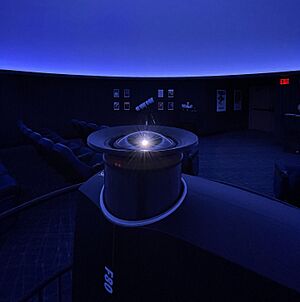
In a fully digital planetarium, a computer creates the image of the night sky. This image is then projected onto the dome using different types of projectors, like LCD, DLP, or laser projectors. Sometimes, one projector with a special fisheye lens is placed in the center to cover the whole dome. Other times, several projectors around the dome's edge work together to create a seamless image.
Digital systems create the sky image using many tiny dots called pixels. The more pixels a system can show, the better the image looks. While early digital projectors weren't as sharp as the best traditional ones, today's high-end systems can create images that are almost as clear as what the human eye can see.
Laser projectors are becoming popular for domes because they create bright images with great contrast and a wide range of colors.
What You See at a Planetarium Show

Most planetariums offer shows for the public. These shows often cover topics like "What's in the sky tonight?" or special events like the Christmas star. Many places prefer live shows because a speaker can answer questions from the audience.
Since the early 1990s, digital planetariums have added an exciting new feature: 3-D views. This means you can "fly" through the universe and see the sky from any point in space, not just from Earth. This virtual reality ability is great for learning because it clearly shows that space has depth. It helps people understand that stars are not just stuck on a giant dome around Earth. Instead, you can see the true arrangement of the Solar System and beyond.
For example, a planetarium can now "fly" you towards a familiar constellation like Orion. You'll see that the stars that look like a shape from Earth are actually very far apart from each other. They are only connected in our imaginations and mythology. For people who learn best by seeing or moving, this experience can be much more helpful than just looking at pictures.
See also
 In Spanish: Planetario para niños
In Spanish: Planetario para niños
- Antikythera mechanism
- Armillary sphere
- Astrarium
- Astrolabe
- Astronomical clock
- Fulldome video
- List of observatory software
- Observatory
- Orrery
- List of planetariums
- Planetarium projector
- Prague Orloj
- Torquetum
- Space-themed music
- Star atlas
External links
- IPS (International Planetarium Society)
- WPD (Worldwide Planetariums Database)


